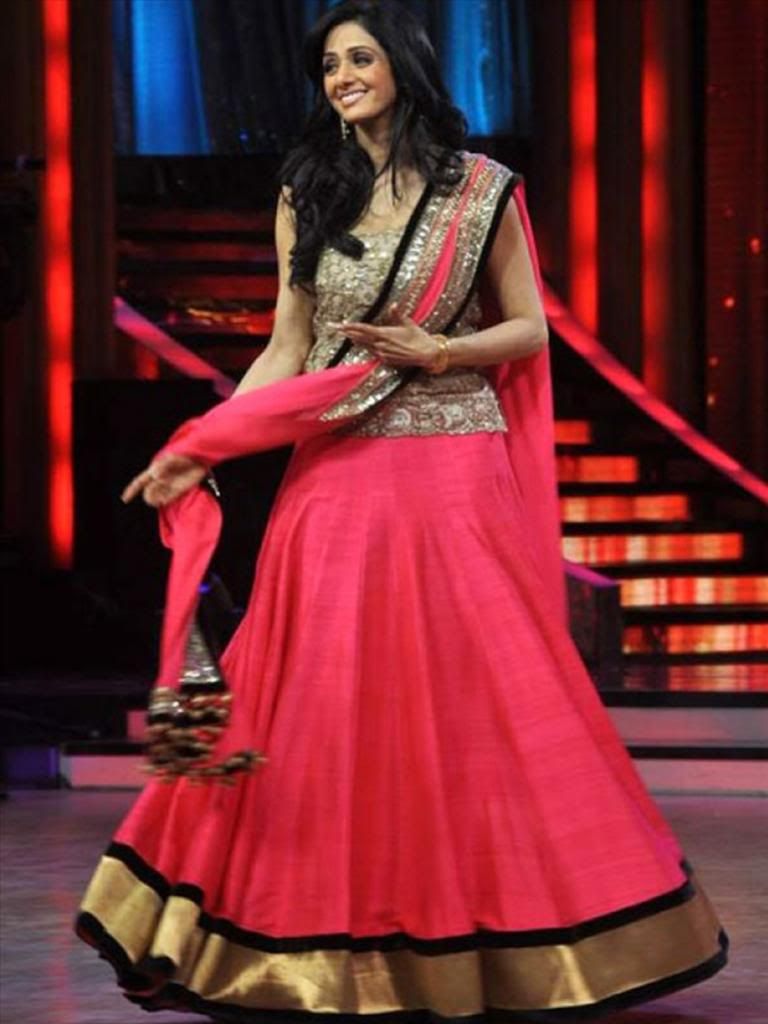Indian Lehenga Biography
Source(Google.com.pk)History
India's recorded history of clothing
goes back to the 5th millennium BC in the Indus Valley civilization
where cotton was spun, woven and dyed. Bone
needles and wooden spindles have been unearthed in excavations at the site. The cotton
industry in ancient India was well developed, and several of the methods
survive until today. Herodotus, an ancient Greek historian described Indian
cotton as "a wool exceeding in beauty and goodness that of sheep". Indian
cotton clothing was well adapted to the dry, hot summers of the subcontinent. The grand epic Mahabharata, estimated to be written
between 3000-4000 BC, has a mention of an uneding saree gifted to Draupadi to protect her dignity. Most of the present knowledge of
ancient Indian clothing comes from rock sculptures and paintings in cave
monuments such as Ellora. These images show dancers and goddesses wearing what appears to
be a dhoti wrap, a predecessor to the modern sari.The upper
castes dressed themselves in fine muslin and wore gold ornaments. The
Indus civilisation also knew the process of silk production. Recent analysis of
Harappan silk fibres in beads have shown that silk was made by the process of reeling, a
process known only to China until the early centuries AD.
Ghagra Choli (lehenga choli)
Is a form of skirt
which is long, embroidered and pleated. It is worn as the bottom portion of a
Gagra choli. It is secured at the waist and leaves the lower back and midriff bare. The
ancient version of skirt or Ghagri evolved
from Bhairnivasani,
which in turn evolved from the Antariya when
stitched on one side became tabular and was worn gathered together at the
waist, and held by a girdle. This was one of the earliest forms of a clumsily
stitched skirt. It was worn using drawstring or nada. The ghagri was a narrow
skirt six feet long the same length as original antariya. This style can still
be seen worn by Jainnuns
in India.
Until early 20th century, women irrespective of
class largely wore gagras which reached down to ankles, especially in Hindi
belt. This was largely due to jeweled toes showed martial status of women as
both married and unmarried women observed Ghoonghat. Gagras were made out of
two to three layers of coarse khadi fabric which created large flared look and
remained largely undecorated but were decorated with gota strips along the
border on special occasions. Most commonly used dyes were Indigo, Lac and
Haldi. This style can still be seen in rural areas of Haryana, Uttar
Pradesh & Madhya
Pradesh particularly
during folk festivals.
Ancient unstitched form
of gagra has survived in folk theater costumes across India, particularly in Kathakali of
Kerala, where layers of pleated khadi fabric are laid over a nada and tied
around the waist creating layers of flared skirt. This reflects simplistic
early style of unstitched gagras worn in ancient times.
.
Variations
The
ghagri was a narrow skirt six feet long the same length as original antariya.
This style can still be seen worn by Jainnuns
in India.
In Andhra
Pradesh it is called as Langa and part of the dress Langa Vo
Until
early 20th century, women irrespective of class largely wore gagras which
reached down to ankles, especially in Hindi belt. This was largely due to
jeweled toes showed martial status of women as both married and unmarried women
observed Ghoonghat.
Gagras were made out of two to three layers of coarse khadi fabric which
created large flared look and remained largely undecorated but were decorated
with gota strips along the border on special occasions. Most commonly used dyes
were Indigo, Lac and Haldi. Ancient unstitched form of gagra has survived in
folk theater costumes across India, particularly in Kathakali of
Kerala, where layers of pleated khadi fabric are laid.Colours
The colour of the choli is usually matched with the colour of the sari. Currently, the cholis are worn in contrast colours to that of the colour of the sari. Colours like black, white, navy blue, deep purple, crimson red, lemony yellow, hot pink and sea green are mostly preferred. The colour of the moment is shades of blue and aqua.
Indian Lehenga Indian Lehnga Dress Suites Design 2014 Choli Photos Pics Images Wallpapers
Indian Lehenga Indian Lehnga Dress Suites Design 2014 Choli Photos Pics Images Wallpapers
Indian Lehenga Indian Lehnga Dress Suites Design 2014 Choli Photos Pics Images Wallpapers
Indian Lehenga Indian Lehnga Dress Suites Design 2014 Choli Photos Pics Images Wallpapers
Indian Lehenga Indian Lehnga Dress Suites Design 2014 Choli Photos Pics Images Wallpapers
Indian Lehenga Indian Lehnga Dress Suites Design 2014 Choli Photos Pics Images Wallpapers
Indian Lehenga Indian Lehnga Dress Suites Design 2014 Choli Photos Pics Images Wallpapers
Indian Lehenga Indian Lehnga Dress Suites Design 2014 Choli Photos Pics Images Wallpapers
Indian Lehenga Indian Lehnga Dress Suites Design 2014 Choli Photos Pics Images Wallpapers
Indian Lehenga Indian Lehnga Dress Suites Design 2014 Choli Photos Pics Images Wallpapers
Indian Lehenga Indian Lehnga Dress Suites Design 2014 Choli Photos Pics Images Wallpapers
Indian Lehenga Indian Lehnga Dress Suites Design 2014 Choli Photos Pics Images Wallpapers
Indian Lehenga Indian Lehnga Dress Suites Design 2014 Choli Photos Pics Images Wallpapers
Indian Lehenga Indian Lehnga Dress Suites Design 2014 Choli Photos Pics Images Wallpapers
Indian Lehenga Indian Lehnga Dress Suites Design 2014 Choli Photos Pics Images Wallpapers
Indian Lehenga Indian Lehnga Dress Suites Design 2014 Choli Photos Pics Images Wallpapers
Indian Lehenga Indian Lehnga Dress Suites Design 2014 Choli Photos Pics Images Wallpapers
















No comments:
Post a Comment